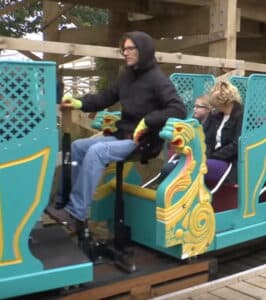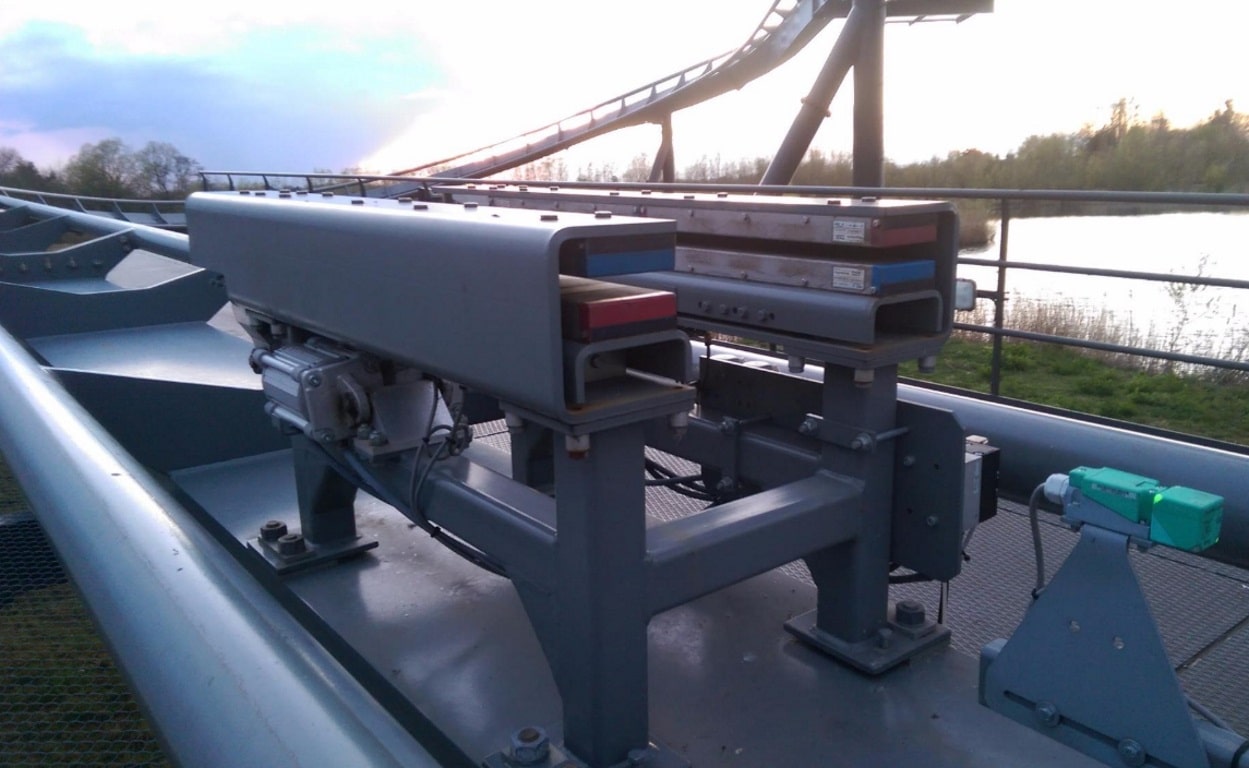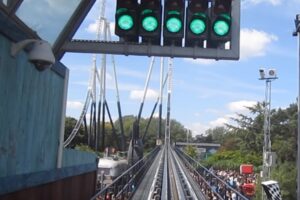The majority of roller coasters do not have any form of braking on the train itself and use braking systems integrated with the roller coaster track to control the trains speed. Various types of braking systems exist with new systems been developed thanks to technological advancements in design. Braking Systems may be located anywhere along a roller coasters circuit and are sometimes hidden from view.
Roller Coaster Braking Systems
The majority of roller coasters do not have any form of braking on the train itself and use brake runs to control the rides speed, these are normally controlled by sophisticated computer systems. One notable exception is the scenic railway roller coaster. A variety of different braking systems are used on roller coasters, dependant on the ride manufacturer, type of ride and its intended method of operation. New braking systems are regularly being developed thanks to technological advancements in design.
Manual Braking System

The Scenic Railway relies on an operator to manually control the speed of the train. The brakeman sits in the middle of the roller coaster train and uses a large brake lever to control the trains speed. Working examples of Scenic Railway Roller coasters can be found at Great Yarmouth Pleasure Beach and Dreamland in Margate.
Trim Brakes
Trim brakes are utilised to adjust a trains speed during its course rather than bringing the train to a complete stop. In modern-day engineering, trim brakes are added to the ride at its design stages to help deal with anticipated trouble spots. Trim brakes can also be retrofitted if it is discovered that trains traverse certain sections of track at a higher speed than anticipated.
Trim brakes are often added for safety reasons, reducing the trains speed and lowering the g-forces experienced by riders. Wear and Tear can also be reduced (especially on wooden roller coasters) with the introduction of trim brakes. Reducing the roller coasters speed can help to lower the maintenance and mechanical costs. A proximity sensor normally precedes the trim brake in order to identify the current speed of the passing train. The control system is notified of the current speed and it sets the pressure of the trim brake in order to reduce the speed as required.
Block Brakes
Block brakes are used on roller coasters where more than one train is intended to run. Block Brakes are used to divide the roller coaster track into independent sections. This is a safety feature as block brakes act as a virtual barrier between each of the trains running on the roller coaster track, preventing collisions should one train fail to complete a section for any reason. A roller coaster train can only proceed onto the next section of the track if the train in front has already completed it. The Number of block brakes determines the number of sections of track and ties in with the number of trains that can be safely operated.
Block brakes must be capable of safely bringing a roller coaster train to a complete stop. Block brake sections are often installed on a slight downward slope so gravity can be used to restart the train once the brakes have been released. An alternative method is to restart the train using drive tyres to push the train out of the block.
Like trim brakes, block brakes can also be used to control the speed of the train. These are usually known as mid-course brake runs. In some examples, a mid-course brake run may slow the roller coaster train down drastically, almost to the point of stopping. This may help to reduce the G-forces riders may experience in the next section of track. Mid-course brake runs help to increase ride time, providing more time for another train to be loaded.
The roller coaster station acts as a block brake, as does the section where trains are often held at the entrance to the station whilst they wait for the train in front to complete loading and depart. The number of trains that can be safely operated on a roller coaster track is based on the number of independent sections.
Skid brakes
Skid brakes essentially involve a long piece of material, often ceramic-covered, situated in the middle of the track parallel to the rails. When the brake is engaged, the skid raises and friction against the underside of the train causes the train to slow and eventually stop. Skid brakes were one of the first advancements in roller coaster braking and are typically not utilized in modern creations.
Fin brakes
Fin brakes get their name from a metal fin attached to the underside of the roller coaster train. The track is fitted with two computer-controlled squeezing mechanisms which upon closing, squeeze the fin and either slow or stop the train. Fin brakes are the most common form of brakes on roller coasters today. Sometimes they are thick metal box beams (mainly found on Bolliger and Mabillard roller coasters), others use thin metal plates. The fins slide between pairs of friction pads similar to automotive brake pads, they are designed with a fail-safe so that in the event of power loss the brakes are engaged. A heavy spring, usually made of steel, is used to hold the brake closed by default. Braking systems are constructed according to a certain measure of redundancy, meaning the ride is usually fitted with one extra set of brakes to bring the train to a complete halt even if one brake fails. The brake blocks attached to the roller coaster track are Opened and closed by air-operated actuators, similar to a set of bellows. Each set of brakes is fitted with its own air supply system controlled by supply valves which open the brake when it is safe to do so.
Magnetic brakes
Magnetic brakes are a relatively new technology that is beginning to gain popularity due to their high degree of safety. Rather than slowing a train via friction (such as skid or fin brakes), which can often be affected by various elements such as rain, magnetic brakes rely completely on certain magnetic properties and resistance. In fact, magnetic brakes never come into contact with the roller train.
Magnetic brakes are made up of one or two rows of neodymium magnets. When a metal fin (typically copper or a copper/aluminium alloy) passes between the rows of magnets, eddy currents are generated in the fin, which creates a magnetic force opposing the fin’s motion. The resultant braking force is directly proportional to the speed at which the fin is moving through the brake element. This very property, however, is also one of the magnetic braking systems disadvantages in that the eddy force itself can never completely bring the train to a complete standstill. Due to this, it is often necessary to utilise an additional set of fin brakes or kicker wheels (which are simple rubber tyres that make contact with the train) to halt the train completely.
Magnetic brakes can be found in two configurations, the brake elements are either mounted to the track or alongside the track and the fins are mounted to the underside or sides of the roller coaster train. This configuration looks similar to frictional fin brakes. Alternatively, the opposite is applied, with the fins mounted to the track and the brake elements mounted to the underside of the train. This configuration can be found on Intamin’s Accelerator Coasters such as Stealth at Thorpe Park.
Magnetic brakes are silent and are much smoother than friction brakes, gradually increasing the braking power so that the people on the ride do not experience rapid changes in deceleration. Many modern roller coasters utilise magnetic braking providing a more comfortable ride experience and lowering maintenance and labour costs.
Due to the fact that Magnetic brakes cannot completely stop a roller coaster train, they are often paired with a set of fin brakes. When the ride is operating normally, the track-mounted fin brakes are retracted to allow the roller coaster train to pass without slowing it down. On a launch roller coaster like Stealth at Thorpe Park. after the train has been successfully launched, the brake fins are raised to safely slow the train down in the event of a rollback.










